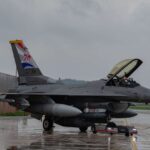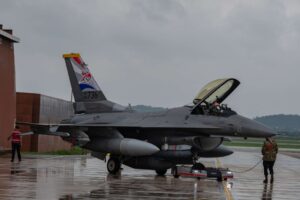The U.S. has enjoyed superiority in military technology since the end of the Cold War. But this edge is being rapidly eroded by its main rival, China, which seems determined to become a global leader in technologies such as artificial intelligence and machine learning (AI/ML) that could potentially revolutionize warfare.
As Beijing focuses on a defense strategy for what it calls the “new era,” the aim is to integrate these innovations into the People’s Liberation Army, creating a “world-class” force that offsets U.S. conventional military supremacy in the Indo-Pacific and tilts the balance of power.
How important AI has become for China’s national security and military ambitions was highlighted by President Xi Jinping during the 20th Party Congress last October, where he emphasized Beijing’s commitment to AI development and “intelligent warfare” — a reference to AI-enabled military systems.
Not only does China plan to become the world’s leading AI power by 2030, Beijing has also turned to a military-civil fusion strategy to achieve it. This approach has enabled the country to speed up defense innovations by eliminating barriers between China’s civilian research and commercial sectors, and its military and defense industrial sectors.
The results are striking. China already produces the most top AI scientists, with the country hosting the first nine of the world’s top 10 institutions publishing AI-related papers, according to Stanford University’s latest AI Index Report.
Moreover, companies such as Tencent Holdings, Alibaba Group Holdings and Huawei Technologies are reported to be among the top 10 firms conducting AI research.
Chinese experts are also prolific, publishing 27.5% of all AI journal articles worldwide, while U.S. researchers account for 12%, according to Stanford’s Institute for Human-Centered AI.
But Beijing’s drive for technological supremacy doesn’t stop with AI. China is beating Western democracies in research output in 37 out of 44 technological areas deemed critical for economic growth and military power, such as space, robotics, energy, the environment, advanced materials and key quantum technology areas, the Australian Strategic Policy Institute said in a recent report.
This has led analysts such as Amy J. Nelson, an expert on emerging technologies at the Brookings Institution, to say that on balance, the U.S. and China are already “neck and neck in technological innovation as best we can measure.”
The key, she says, is how these technologies will be operationalized.
“China is renowned for its data collection and thus algorithm development, which will likely define its advantage going forward,” Nelson said.
“The U.S. struggles to reach equivalence in this area, so if China’s data collection efforts make for a measurable improvement to its algorithms relative to U.S. ingenuity, China could take the lead.”
Why does this matter?
Even though the PLA views AI/ML as crucial for driving next-generation warfare, little is known on how exactly it will integrate AI or what operational concepts it will adopt.
Nevertheless, Beijing already stated in its 2019 Defense White Paper that the application of cutting-edge technologies — including AI, quantum information, big data, cloud computing and the Internet of Things — is “gathering pace in the military field.”
China’s technological leapfrogging has caused great concern in Washington and is considered a key factor behind the U.S. decision to impose sweeping restrictions on semiconductor exports to Beijing.
This comes as the edge AI/ML provides on the battlefield is becoming increasingly apparent. From autonomous systems and accelerated data analysis to disinformation operations, intelligence gathering, cyberattacks, and human-machine teaming, experts have found multiple tactical and strategic applications for these technologies.
“AI will transform the way war is conducted in every domain from undersea to outer space, as well as in cyberspace and along the electromagnetic spectrum,” said the U.S. National Security Commission on Artificial Intelligence (NSCAI) in a 2021 report.
Enablers, multipliers and disruptors
Depending on their use, AI/ML-enabled technologies are broadly classified as force enablers, multipliers and/or disruptors.
For instance, they can serve as enablers as they can improve situational awareness and intelligence capabilities by speeding up the processing of large and complex data sets.
This is because the combination of machine learning with big data provides analytical capabilities that are beyond what humans could do.
“As an increasing amount of data is generated on battlefields, the capacity to analyze and manage large amounts of data faster than an adversary is critical,” said Jean-Marc Rickli and Federico Mantelassi from the Geneva Center for Security Policy (GCSP).
“Not only can AI systems digest, categorize and analyze more data than human analysts, but they may also find correlations in data that escape the human mind,” the experts added, noting that AI-enabled systems can process data from intelligence, surveillance and reconnaissance sensors by sifting through massive troves of texts, images and audio, unburdening the work of analysts.
The PLA reportedly aims to use AI to process information from many sources, including from a network of unmanned systems and undersea sensors surrounding China.
These technologies can also be applied to help commanders make better, faster and more relevant battlefield decisions while supporting the planning of military operations, particularly in constrained times.
This is crucial as China expects the tempo of military operations to eventually outpace human cognition, which is why the PLA wants AI to enhance its command-and-control structure and achieve “decision superiority” in “intelligent” warfare, Rickli said.
The idea is for algorithms to help connect the dots where humans alone may not see the full picture.
Aside from information processing, there are other key applications. Nearly all advanced militaries, including those of China, Russia, and the U.S., are selectively experimenting with AI technologies that integrate with robotics and drones.
Moreover, they are developing “collaborative combat” systems, integrating human-machine interactions such as unmanned drones flying in-sync with advanced fighter jets, said Michael Raska, coordinator of the Military Transformations Program at the Singapore-based S. Rajaratnam School of International Studies.
Other military uses include cyber operations, detecting and countering advanced cyberattacks, logistics and predictive maintenance applications that can optimize the availability and deployments of military units and assets, added Raska, who is also the editor of a new book titled, “The AI Wave in Defence Innovation: Assessing Military Artificial Intelligence Strategies, Capabilities, and Trajectories.”
Another major area of research and development is autonomous vehicles that evacuate wounded soldiers from the battlefield.
AI can also function as a disruptor in cognitive warfare, for instance, to support disinformation campaigns, meaning that ascertaining the veracity and value of information will become harder.
Advances in natural language processing and deep learning are already leading to more fictitious content, or deepfakes, through either fake text, images or videos, said Rickli.
But these applications might just be the tip of the iceberg, as new uses are bound to emerge.
Raska points out that AI systems could infiltrate a rival’s network and data centers to manipulate algorithms or corrupt data. Furthermore, they could play a key role in lethal autonomous weapons systems, including aerial and underwater drones that could be used in swarms.
There is one key problem, Raska said. These emerging technologies raise the uncertainties of data integrity, bias and reliability issues, which can lead to unforeseen consequences.
Moreover, there is the question of whether existing norms and governance mechanisms would prevent militaries from moving into a new phase of “automation warfare,” where algorithms enable robotic weapons to select and engage targets without human control.
China’s progress in AI will depend upon its capacity to operationalize emerging military systems, which experts say will require overcoming current technological and organizational challenges in testing, training, and operational concepts.
The conclusion is a sobering one for the U.S. and its allies: A new arms race has begun, with no rules and few guardrails.
Unless quick action is taken, the balance of military-technological power will soon shift from West to East, with potentially unforeseen consequences.
Source: Japan Times
















